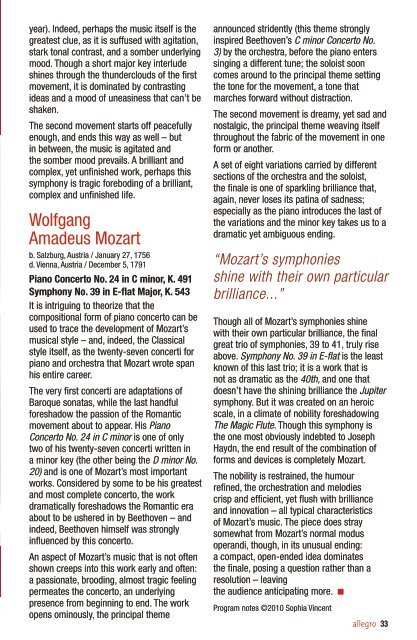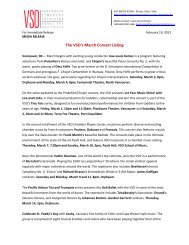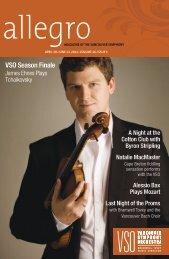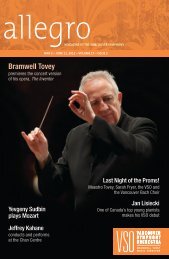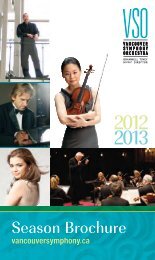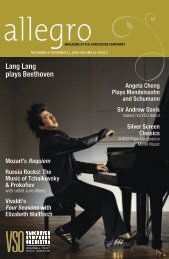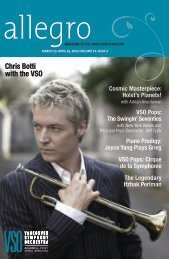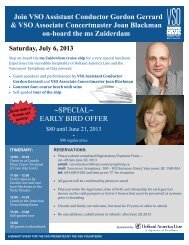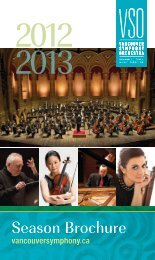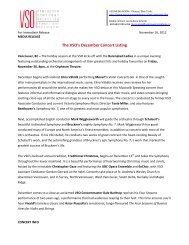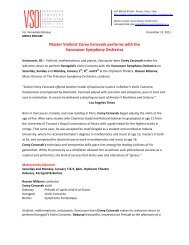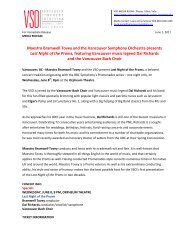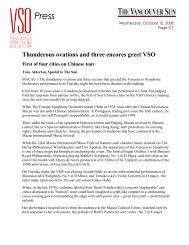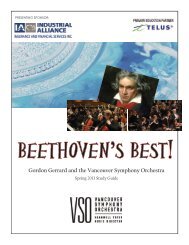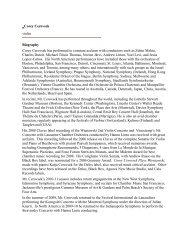issue one - Vancouver Symphony Orchestra
issue one - Vancouver Symphony Orchestra
issue one - Vancouver Symphony Orchestra
Create successful ePaper yourself
Turn your PDF publications into a flip-book with our unique Google optimized e-Paper software.
year). Indeed, perhaps the music itself is the<br />
greatest clue, as it is suffused with agitation,<br />
stark tonal contrast, and a somber underlying<br />
mood. Though a short major key interlude<br />
shines through the thunderclouds of the first<br />
movement, it is dominated by contrasting<br />
ideas and a mood of uneasiness that can’t be<br />
shaken.<br />
The second movement starts off peacefully<br />
enough, and ends this way as well – but<br />
in between, the music is agitated and<br />
the somber mood prevails. A brilliant and<br />
complex, yet unfinished work, perhaps this<br />
symphony is tragic foreboding of a brilliant,<br />
complex and unfinished life.<br />
Wolfgang<br />
Amadeus Mozart<br />
b. Salzburg, Austria / January 27, 1756<br />
d. Vienna, Austria / December 5, 1791<br />
Piano Concerto No. 24 in C minor, K. 491<br />
<strong>Symphony</strong> No. 39 in E-flat Major, K. 543<br />
It is intriguing to theorize that the<br />
compositional form of piano concerto can be<br />
used to trace the development of Mozart’s<br />
musical style – and, indeed, the Classical<br />
style itself, as the twenty-seven concerti for<br />
piano and orchestra that Mozart wrote span<br />
his entire career.<br />
The very first concerti are adaptations of<br />
Baroque sonatas, while the last handful<br />
foreshadow the passion of the Romantic<br />
movement about to appear. His Piano<br />
Concerto No. 24 in C minor is <strong>one</strong> of only<br />
two of his twenty-seven concerti written in<br />
a minor key (the other being the D minor No.<br />
20) and is <strong>one</strong> of Mozart’s most important<br />
works. Considered by some to be his greatest<br />
and most complete concerto, the work<br />
dramatically foreshadows the Romantic era<br />
about to be ushered in by Beethoven – and<br />
indeed, Beethoven himself was strongly<br />
influenced by this concerto.<br />
An aspect of Mozart’s music that is not often<br />
shown creeps into this work early and often:<br />
a passionate, brooding, almost tragic feeling<br />
permeates the concerto, an underlying<br />
presence from beginning to end. The work<br />
opens ominously, the principal theme<br />
announced stridently (this theme strongly<br />
inspired Beethoven’s C minor Concerto No.<br />
3) by the orchestra, before the piano enters<br />
singing a different tune; the soloist soon<br />
comes around to the principal theme setting<br />
the t<strong>one</strong> for the movement, a t<strong>one</strong> that<br />
marches forward without distraction.<br />
The second movement is dreamy, yet sad and<br />
nostalgic, the principal theme weaving itself<br />
throughout the fabric of the movement in <strong>one</strong><br />
form or another.<br />
A set of eight variations carried by different<br />
sections of the orchestra and the soloist,<br />
the finale is <strong>one</strong> of sparkling brilliance that,<br />
again, never loses its patina of sadness;<br />
especially as the piano introduces the last of<br />
the variations and the minor key takes us to a<br />
dramatic yet ambiguous ending.<br />
“Mozart’s symphonies<br />
shine with their own particular<br />
brilliance...”<br />
Though all of Mozart’s symphonies shine<br />
with their own particular brilliance, the final<br />
great trio of symphonies, 39 to 41, truly rise<br />
above. <strong>Symphony</strong> No. 39 in E-flat is the least<br />
known of this last trio; it is a work that is<br />
not as dramatic as the 40th, and <strong>one</strong> that<br />
doesn’t have the shining brilliance the Jupiter<br />
symphony. But it was created on an heroic<br />
scale, in a climate of nobility foreshadowing<br />
The Magic Flute. Though this symphony is<br />
the <strong>one</strong> most obviously indebted to Joseph<br />
Haydn, the end result of the combination of<br />
forms and devices is completely Mozart.<br />
The nobility is restrained, the humour<br />
refined, the orchestration and melodies<br />
crisp and efficient, yet flush with brilliance<br />
and innovation – all typical characteristics<br />
of Mozart’s music. The piece does stray<br />
somewhat from Mozart’s normal modus<br />
operandi, though, in its unusual ending:<br />
a compact, open-ended idea dominates<br />
the finale, posing a question rather than a<br />
resolution – leaving<br />
the audience anticipating more. ■<br />
Program notes ©2010 Sophia Vincent<br />
allegro 33


